The Importance of Bathroom Fluorescent Light Covers
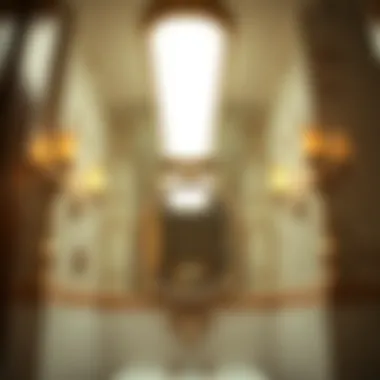

Intro
In any home, bathrooms often take a backseat when it comes to design and functionality. However, it’s in these small, often cramped spaces that smart lighting choices can make a significant difference. One essential component to consider is the bathroom fluorescent light cover. Both practical and decorative, these covers not only serve a vital function but also contribute to the overall aesthetic of the space. Understanding their significance helps in navigating choices that range from efficiency to style and sustainability.
The importance of bathroom fluorescent light covers can’t be overstated. They protect the light fixtures while helping diffuse the light evenly, creating a bright yet inviting atmosphere in what can sometimes feel like a utilitarian space. Various designs and materials are available, allowing homeowners to tailor their choices to fit specific needs and preferences. With a touch of consideration for energy efficiency and maintenance, one can transform mundane bathroom lighting into a functional and appealing feature.
Current Trends
The world of bathroom design is constantly evolving, and fluorescent light covers are not exempt from these trends. Today’s homeowners are more conscious of how light plays a role in setting the mood and function of their bathroom spaces. From color palettes to popular styles, here’s a look at what’s capturing attention.
- Color Palettes: Neutral tones, such as whites, grays, and soft pastels continue to dominate. These colors emphasize cleanliness and airiness. In contrast, bold colors like navy blue or forest green are emerging for those looking to make a statement.
- Popular Styles: Modern minimalism is in vogue. Sleek, streamlined designs that focus on form and function without clutter are favored. Meanwhile, vintage-style covers that add a nostalgic touch are also making their rounds, particularly in retro-themed bathrooms.
Visual Ideas
Imagining how light covers fit into a bathroom is easier when visual examples are at hand. Styles can vary widely, so looking at a gallery of styled bathrooms can provide inspiration.
- Gallery of Styled Bathrooms: Look for images showcasing a variety of light covers, from simple and discreet to elaborate and artistic. This range can spark ideas about which design might work best in your own home.
- Before-and-After Transformations: Often, the difference between outdated and modern is as simple as updating the light covers. Seeing the stark contrast can inspire homeowners to rethink their spaces and the elements that contribute to them.
"Lighting can transform a space from dreary to extraordinary, with the right covers making all the difference."
For further reading or DIY tips, consider resources like Wikipedia and Britannica for a deeper dive into lighting solutions. Additionally, forums on Reddit can offer valuable insights from fellow homeowners about their experiences and choices.
Prelims to Bathroom Lighting
When stepping into a bathroom, the immediate ambiance can make a world of difference. Imagine trying to freshen up or relax in a dimly lit space—it just doesn't cut it. This section dives into the realm of bathroom lighting, emphasizing its crucial role, especially as we look into bathroom fluorescent light covers.
Importance of Proper Lighting
Proper lighting in bathrooms is not just about flipping a switch; it sets the tone and allows for a functional and safe environment. The right amount of light helps you accomplish tasks such as grooming or applying makeup. Poor lighting can lead to mistakes, like missing that one pesky hair when shaving or not applying makeup evenly. It can create an atmosphere that feels unwelcoming, making one feel like they’re wandering in a cave. Furthermore, bathrooms can often become damp places, and adequate lighting also offers a safety net—reducing the risks of slips and falls.
Appropriate light levels can transform an ordinary bathroom into an inviting oasis, where one can linger a bit longer, perhaps even reading a book during a warm bath.
Types of Lighting in Bathrooms
Understanding the different types of lighting options is key. It's not one-size-fits-all, and some choices can dramatically alter the bathroom experience:
- Ambient Lighting: This is the broad illumination that fills the entire space. Think of fluorescent ceiling fixtures that offer a general glow. They lay the foundation for clarity and comfort.
- Task Lighting: As the name suggests, this is aimed at specific tasks. It usually comes from fixtures installed above or beside mirrors, allowing for clearer visibility during shaving or makeup application.
- Accent Lighting: For those wishing to add a touch of luxury or focus on a beautiful feature, this kind of lighting can highlight artwork or decorative elements, illuminating the room just enough to add charm without overpowering.
- Natural Lighting: If you're lucky enough to have windows in your bathroom, natural light is the crème de la crème of bathroom illumination. It reflects colors accurately and tends to create a warm and inviting space during the day.
Using a combination of these lighting types can create a layered effect that not only improves functionality but also enhances the overall aesthetic of the bathroom. Creating a balanced blend can assure that any bathroom feels bright, lively, and welcoming.
In essence, getting bathroom lighting right is a matter of practical safety, utility, and visual appeal—it’s about finding that sweet spot that caters to both functionality and comfort.
Overview of Fluorescent Lighting
Fluorescent lighting has long been a go-to choice in bathrooms, providing bright illumination that’s both energy-efficient and effective. Understanding its role in bathroom lighting is crucial as it sets the stage for maximizing both ambiance and functionality. Many homeowners opt for fluorescent fixtures due to their longevity and lower energy consumption compared to traditional incandescent bulbs.
In any setting, but especially in bathrooms where visibility is key, the type and quality of lighting can directly influence mood and aesthetics. Fluorescent lights come in various shapes and sizes, making them versatile options for different bathroom layouts. They can fit snug above sinks or in larger fixtures that illuminate the entire space.
Benefits of Fluorescent Lighting
- Energy Efficiency: One primary advantage of fluorescent lights is their energy efficiency. They consume less electricity than traditional bulbs while still delivering high luminosity, which can significantly lower utility bills over time.
- Longevity: Fluorescent fixtures often have a longer lifespan than incandescent lights. Some can last up to 10,000 hours or more, reducing the frequency of replacements.
- Variety of Designs: Available in numerous styles, fluorescent lights can suit various tastes, from sleek modern designs to more classic looks. This adaptability allows homeowners to find a fit that complements their bathroom decor.
"Investing in fluorescent lighting not only brightens up your bathroom but also scores points in energy savings."
Drawbacks of Fluorescent Fixtures
Despite their advantages, fluorescent lighting is not without drawbacks.
- Color Rendering Issues: One common complaint is the quality of light. Many fluorescent lights can distort colors, making it difficult to achieve true color representation, which is particularly important when applying makeup or grooming.
- Flickering and Noise: Some homeowners experience flickering or buzzing sounds with fluorescent fixtures, which can be distracting in a space meant for relaxation.
- Potential Toxicity: Fluorescent lights contain small amounts of mercury, a hazardous material that poses disposal challenges. Improper disposal can lead to environmental issues.
In summary, while fluorescent lighting holds significant advantages for bathroom use due to its energy efficiency and durability, it’s essential to carefully consider the potential downsides, such as color rendering and environmental concerns.
Function of Light Covers
Light covers play a vital role in the effectiveness and aesthetics of fluorescent lighting, especially in spaces like bathrooms where proper illumination is essential. Their utility goes beyond mere decoration; they function as critical components that enhance light distribution, manage glare, and contribute to overall safety.
Light Distribution
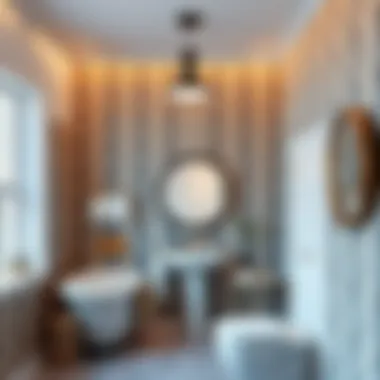
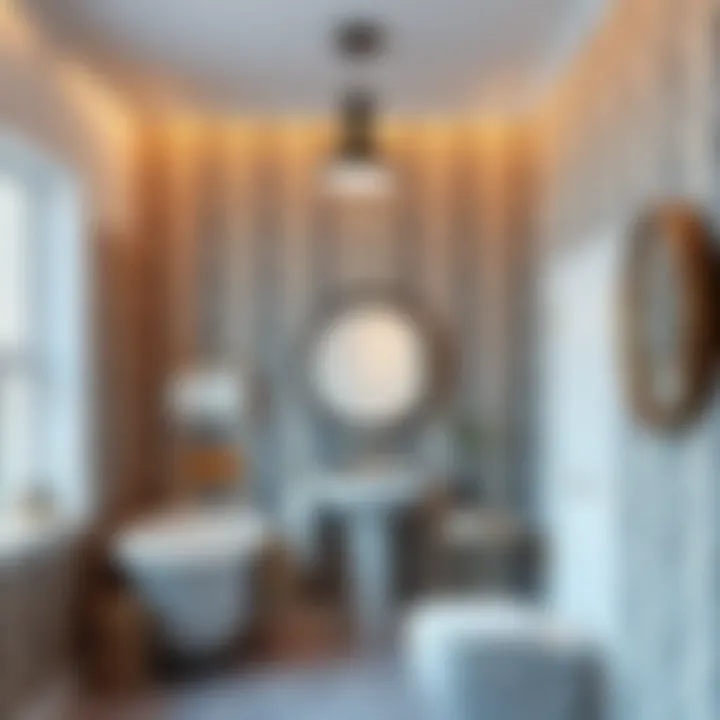
Fluorescent light covers are designed to evenly distribute light throughout a bathroom. When you live in a home, illuminating every nook and cranny can be a challenge, especially with the often harsh nature of fluorescent bulbs. Using an appropriate cover helps maximize light spread, preventing those dreaded dark corners that can make a room feel unwelcoming.
For instance, a frosted acrylic cover can diffuse the harsh rays from a bare bulb, softening the light and making it more pleasant. This even distribution not only improves visibility but also enhances the ambiance of your bathroom, making it feel warmer and more inviting.
Additionally, consider the layout of your bathroom when selecting a light cover. A cover that spreads light more evenly can help in larger spaces, where one fixture might not suffice. This means careful choice in shape and size. Rectangular covers work well over vanities, while round ones might be ideal for compact spaces. Knowing what fits where can elevate your lighting game.
Reducing Glare
Glare can be a serious nuisance, especially in a bathroom setting, where bright fluorescent lights sometimes cast annoying reflections off shiny surfaces like mirrors. This is where light covers shine in terms of practical benefits. A good cover significantly reduces glare, making it easier on the eyes while you go about your grooming routines.
Some covers are specifically designed with textured surfaces that absorb excess light. This trait is particularly beneficial for individuals who may find bright lights uncomfortable, helping to maintain a more tranquil environment.
It's worth mentioning that a little research into the design options available can pay big dividends. Some of the newer models incorporate features that combat glare through innovative patterns or materials designed for soft illumination. Furthermore, it’s a win-win situation, as reduced glare not only increases comfort but also improves the overall visual appeal of the room.
Materials Used in Fluorescent Light Covers
When it comes to illuminating your bathroom, the materials chosen for fluorescent light covers play a role that's as vital as the light themselves. Not only do these materials affect the quality and diffusion of light, but they also contribute significantly to safety and durability over time. Selecting the right cover involves more than just aesthetics; it's about understanding how different materials work and their practical implications.
Acrylic vs. Polycarbonate
Acrylic and polycarbonate are two heavyweights in the realm of fluorescent light covers.
- Acrylic is a favorite due to its lightweight nature and versatility. It can mimic glass but is less likely to shatter. A major perk? It holds up well against the elements, making it suitable for bathrooms, where humidity reigns supreme.
- Polycarbonate, on the other hand, takes durability up a notch. It's often stronger than acrylic, being resistant to impacts and wear from everyday use. However, it can be a bit more costly, and the appearance may not always match with all bathroom styles.
- Pros of Acrylic:
- Transparency: Allows for excellent light diffusion.
- Weight: Much lighter than glass.
- Shatter Resistance: Less prone to breakage, beneficial in busy households.
- Pros of Polycarbonate:
- Durability: Stands up to high impacts and heavy usage.
- Heat Resistance: Performs better under high temperatures.
- Long-lasting: Less likely to discolor over time compared to acrylic.
In terms of choice, it often boils down to personal preference and usage. If you're looking for a cover that’s easy to install and replace, acrylic might do the trick. However, if rugged durability is a priority, polycarbonate becomes a worthy contender.
Glass Options
Glass, while not as commonly used nowadays as acrylic or polycarbonate, still holds a special place in the design world of fluorescent light covers. It provides a classic touch that can elevate bathroom aesthetics.
- One advantage of using glass is its ability to enhance the overall look of the fixture. It can be frosted, clear, or even textured, offering a range of styles to suit any decor.
- While heavier, glass offers superior clarity and does not scratch as easily as plastic options. This makes them ideal for those who prioritize both beauty and durability; however, it’s essential to handle glass installations with care given its fragile nature.
- A drawback to consider is regarding safety, particularly in a moisture-rich environment like a bathroom. Ensure that any glass cover you choose is specifically rated for such uses, minimizing the risk of shattering in humid conditions.
Selecting the right material for your bathroom fluorescent light covers isn’t just a matter of personal taste or design. It’s a practical decision that impacts lighting efficiency, maintenance, and safety. Understanding what’s available helps housewives and home owners make a more informed choice in creating a beautiful, functional space.
"The right material doesn’t just light up a room; it can transform it into a sanctuary."
In the end, the choice between acrylic, polycarbonate, or glass must align with the balance of your bathtub's environment and your stylistic desires. By thoughtfully considering these materials, you'll not only ensure effective lighting but also enrich the calming essence that a bathroom should evoke.
For further exploration into the material science behind lighting fixtures, consider visiting Wikipedia or Britannica.
Whether you're switching things up or starting from scratch, knowing your options equips you to make better decisions.
Design Considerations
When it comes to choosing fluorescent light covers for bathrooms, design considerations play a crucial role in functionality and aesthetics. Not just any cover will do; it needs to blend seamlessly into your space while serving its purpose effectively. The interplay of style, material, color, and size can enhance or dampen the overall vibe of your bathroom. Missteps in design can lead to an awkward aesthetic or, worse, ineffective lighting.
The right light cover can amplify natural light, reduce harsh glows, or even add an architectural element to the space. While one might think that a light cover’s primary job is merely functional, a well-chosen design can detract from your decor or even contribute to noise levels in your bathroom. Thus, weighing the design aspects carefully is essential for both new renovations or simple updates.
Choosing the Right Style
Choosing the right style for your fluorescent light cover can be a bit like picking the perfect frame for a cherished photograph. You want something that enhances the beauty of the bathroom rather than takes center stage. Is your bathroom modern with clean lines, or is it more traditional with intricate details? A minimalist frosted cover works well in a contemporary setting, while something textured in design may suit a vintage-style bathroom better.
Here are some considerations:
- Size Matters: The proportion of the light cover to your fixtures can make a big difference. A large cover in a small bathroom can overwhelm the space.
- Form and Function: Remember, style is as important as how well it diffuses the light. A stylized cover that doesn’t manage glare effectively might not be the best option.
- Color Choices: Light covers come in various tones. A white or neutral palette is versatile but consider colored or custom options if they align with your color schemes.
To illustrate, imagine a bathroom with a sleek and modern aesthetics. Chandeliers or decorative fixtures pair well with elegant frosted covers that let just enough light filter through without being too harsh. On the flip side, a farmhouse-style bathroom could shine with rustic or wood-toned covers that complement wooden accents and earthy color schemes.
Integrating with Bathroom Decor
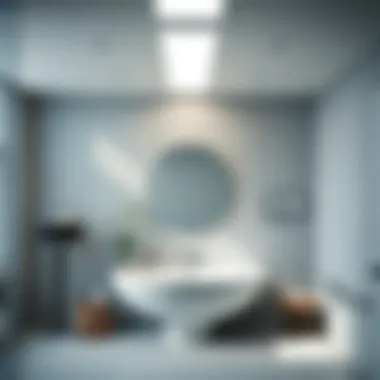
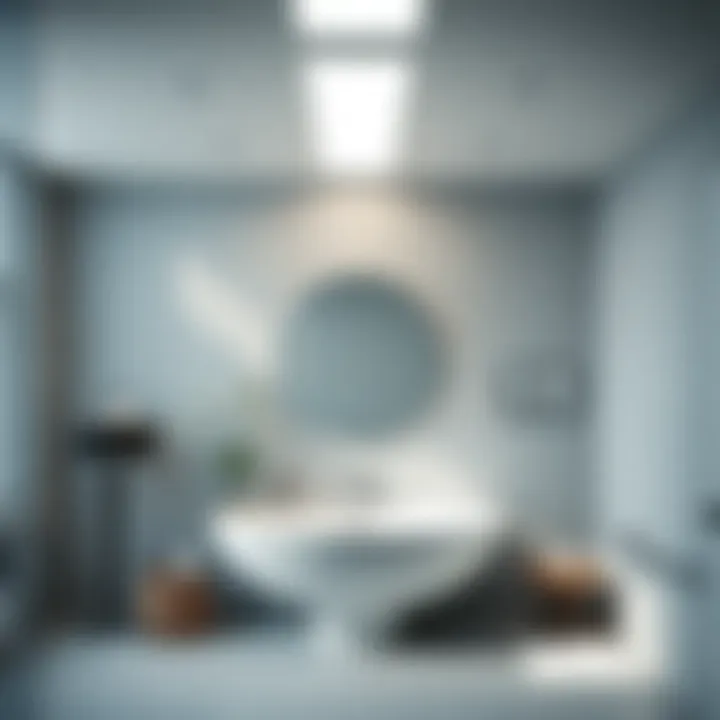
Merely placing a fluorescent light cover in your bathroom isn’t enough; it must also effectively integrate with existing decor. This includes melding different elements, such as tiles, faucets, and any artwork. The goal is to create a cohesive breathing space with harmony among all parts, ensuring everything works together rather than looking like it was haphazardly arranged.
- Matching Textures and Colors: If your bathroom has textured tiles, consider a light cover that mirrors those textures. It creates a feeling of continuity.
- Accessorizing with Intent: Pay attention to other elements like mirrors or towel racks. A metallic cover might look stunning in a bath adorned with brass fixtures, while a matte cover could complement a more subdued aesthetic.
- Creating Zones: If your bathroom has specific areas for dressing or relaxation, thoughtful lighting choices can help distinguish these zones. A more decorative cover may work in a space meant for ambiance, while a functional cover can be used in a bright-light zone for daily tasks.
Ultimately, the integration of your light cover with the bathroom decor fosters not only a visually appealing space but also a more inviting one, making your bathroom a sanctuary for all the right reasons.
"Good design is about more than just aesthetics; it’s about crafting spaces that feel right and serve their purpose as intended."
As you consider these aspects of design, remember that the perfect light cover can uplift your space's utility and visual flair, all while meeting the practical needs of a well-lit and comfortable bathroom. For additional insights on interior design and lighting, visit websites like Wikipedia or Britannica.
Installation Process
The installation process of bathroom fluorescent light covers is a pivotal step that significantly influences both the functionality and aesthetics of your bathroom lighting. When done correctly, it can enhance the overall brightness of the space, making your bathroom not just more visible but also more inviting.
When you're installing light covers, it’s crucial to consider factors such as the specific layout of your bathroom, the wattage of the fluorescent lights, and the size and shape of the light covers. An optimally installed cover contributes to better illumination and reduces the risk of shadows, which can be a hindrance when performing tasks in the bathroom, like shaving or applying makeup. Moreover, a well-fitted light cover can minimize flickering issues that might be caused by poor connections during the installation.
Here's what you need to know about the tools required and the steps involved for a seamless installation process.
Tools Required for Installation
Before you dive into the installation, gathering the right tools can save you headaches later. Here is a list of essential tools you will likely need:
- Screwdriver: A flathead or Phillips, depending on the type of screws used in your light fixture.
- Drill: For making new holes if necessary.
- Wire Strippers: To prepare the electrical wires for connection.
- Voltage Tester: This ensures the circuit is off, enhancing safety during installation.
- Measuring Tape: For precise measurements of light cover dimensions.
- Level: To ensure your light cover is straight.
Being prepared with these tools will not only keep the process smooth but also prevent any unexpected delays.
Steps to Proper Installation
Installing fluorescent light covers is a task that can generally be undertaken by most homeowners. Here’s a straightforward guide to get you on your way:
- Turn Off Power: Safety is paramount. Always switch off the circuit breaker and use the voltage tester to confirm there's no power.
- Remove the Old Cover: Carefully detach the existing light cover. This usually involves unscrewing it from the fixture or gently unclipping it, depending on the design.
- Inspect the Fixture: Check the fluorescent lights and fixture for any damage or wear and tear. If you notice any issues, it’s better to address them now.
- Prepare New Cover: If needed, trim the new light cover using your measuring tape to ensure a snug fit. Make adjustments slowly and measure twice.
- Install the New Cover: Align the new light cover with the fixture and either screw or clip it into place securely.
- Check the Level: Use your level to make sure the cover is even. A wonky light cover can be a visual annoyance.
- Restore Power: Once everything is in place, turn the power back on and test your new installation.
- Final Adjustments: Adjust the position of the light cover if necessary to ensure it’s perfectly aligned.
Following these steps will aid in achieving a professional-looking installation. Remember, a poorly installed cover can lead to operational issues and diminish the benefits of fluorescent lighting. By putting in the effort to do it right, you ensure long-term function and visual appeal in your bathroom's lighting scheme.
"Proper installation of bathroom fixtures can make all the difference. It’s the little things that count."
For more insights on light installations, you can refer to educational resources such as This Old House, a great guide for home improvement tips.
Maintenance and Cleaning
Maintaining and cleaning bathroom fluorescent light covers is essential for both aesthetic and functional reasons. Over time, dust, moisture, and grime can accumulate on light covers, affecting not only their appearance but also the quality of lighting in your space. Fluctuating between dim and bright light can be exhausting, so keeping these fixtures clean ensures you get consistent illumination.
Moreover, regular maintenance can prolong the lifespan of your light covers. Fluorescent bulbs emit heat, and if dirt builds up, it can lead to overheating and ultimately, fixture failure. Thus, maintaining clean light covers is a proactive step that minimizes future repair costs and enhances the overall safety of your bathroom. This section delves into effective cleaning techniques suited for various materials and offers insights into how to care for your fluorescent light covers in the long run.
Cleaning Techniques for Different Materials
Cleaning techniques can vary based on the material of the light cover. Here are some tailored methods for the most common types:
- Acrylic Covers: Use a mixture of warm water and mild soap. A soft cloth works best—putting a little elbow grease is all it takes to get past the grimy spots. Rinse with clear water and dry thoroughly to avoid streaks.
- Polycarbonate Covers: These are sturdier and can handle a stronger cleaning agent. A solution of vinegar and water can be employed here. Spray it on, wipe it down, and that's usually enough to keep everything spick and span.
- Glass Covers: Glass covers often require a bit more care to prevent scratches. A glass cleaner applied with a microfiber cloth usually does the trick. Make sure to avoid any abrasive scrubbers that might leave marks.
"Regularly attending to your bathroom fixtures not only enhances their longevity but also elevates the overall vibe of the space."
Long-term Care to Extend Lifespan
Taking care of your fluorescent light covers isn't just about a quick wipe-down. It’s about developing a long-term care strategy. Here are key steps to consider:
- Scheduled Cleaning Routine: Setting a cleaning schedule can help you keep on top of grime. Perhaps every month or after seasonal changes could work.
- Inspect for Damage: Take a close look during your cleaning sessions. Cracks or discolorations can signal that the cover is nearing the end of its life. Catching these signs early could prevent a more significant issue down the line.
- Proper Handling: When changing bulbs or cleaning, be sure to treat the covers with care. Dropping or mishandling can lead to cracks or breakage.
- Storage Considerations: If you ever need to remove the light covers for any reason, store them in a safe place. Keep them away from heavy objects to avoid unnecessary stress that could lead to damage.
By focusing on these areas, you not only maintain cleanliness but also ensure that your fluorescent light covers serve you well for years to come.
Energy Efficiency and Environmental Impact
When it comes to bathroom lighting, energy efficiency isn’t just about saving a few bucks on your electric bill; it’s a crucial aspect that contributes significantly to environmental sustainability. The selections made in terms of light sources—like fluorescent lights—affect both energy consumption and ecological footprints. By delving into this aspect, we can appreciate better how these seemingly simple choices can foster a larger, planetary impact.
Comparing Fluorescent to Other Lights
Fluorescent lighting, especially in bathroom settings, can often clash with other types available—like incandescent and LED lighting. Each of these options comes with distinct pros and cons. For instance:
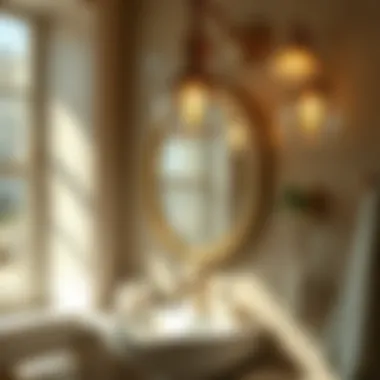
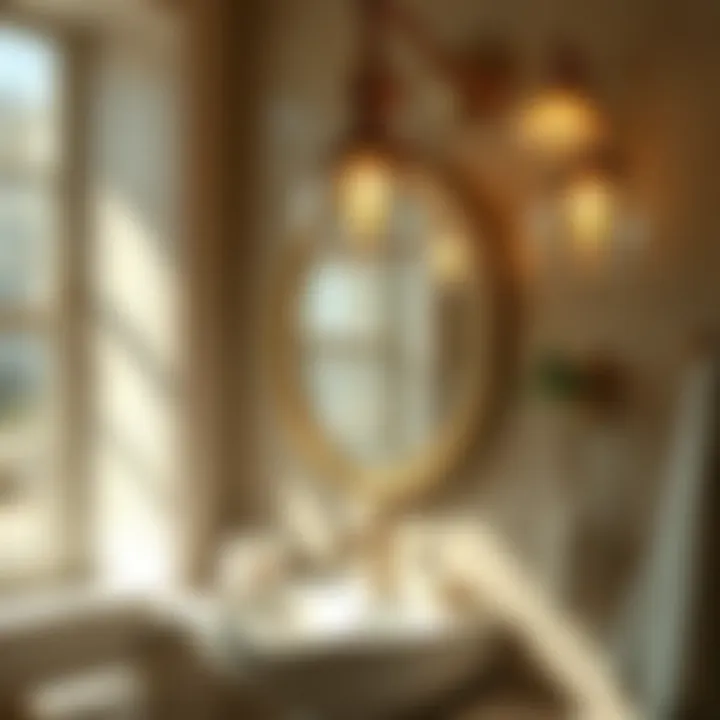
- Fluorescent Lighting:
- Incandescent Bulbs:
- LED Lighting:
- Uses about 75% less energy than incandescent bulbs.
- Offers a life expectancy of around 7,000 to 15,000 hours.
- Generally cheaper to buy, but they consume more energy and have a shorter life span.
- Typically last about 1,000 hours.
- While initially pricier, LEDs have an impressive life span of around 25,000 to 50,000 hours.
- Require significantly less wattage compared to incandescent or fluorescent options, making them substantially cost-effective in the long run.
It’s crucial to note that while fluorescent lights stand strong in energy efficiency, newer technologies like LEDs have begun to challenge their dominance due to their even lower energy consumption and longer lifespans. This competition sparks essential discussions for home lighting choices, particularly for homeowners concerned about not just their wallets but also the environment.
Sustainability Considerations
Now, when we talk about sustainability, we’re looking at how our lighting choices influence not only our immediate living space but also the ecosystem we inhabit. Fluorescent fixtures are generally more eco-friendly than conventional incandescent bulbs due to their reduced power consumption. However, there’s another layer to examine: disposal and safety.
- Waste and Disposal:
Fluorescent bulbs contain small amounts of mercury, which can be harmful if improperly disposed. Households should look into local regulations on recycling and disposal that can differ from one location to another. - Energy Production:
Moreover, every unit of energy consumed can have a ripple effect that stems from how that energy is produced. If the electricity powering your fluorescent bulbs is derived from fossil fuels, the environmental benefits may be negated somewhat. Thus, considering greener energy sources like solar or wind becomes crucial.
In discussing energy efficiency and sustainability regarding fluorescent lighting, it becomes clear that these choices aren’t standalone decisions; they are part of a broader commitment to responsible living. As house owners and housewives alike strive to create a harmonious home environment, understanding these elements ensures better informed and environmentally conscious decisions can be made for years to come.
"The choices we make today shape the world we live in tomorrow."
By integrating energy-efficient lighting like fluorescent fixtures and understanding their environmental impacts, households can contribute to a larger, positive change. Reflecting on the overall influence of light choices will only enhance the effectiveness of ongoing efforts towards sustainability in our communities and our homes.
Common Problems and Solutions
Bathroom fluorescent light covers, while serving essential functions, can sometimes face issues that affect their efficacy and overall performance. Understanding these common problems is critical for homeowners and those overseeing bathroom renovations. Being aware of potential hiccups ensures that you can maintain both aesthetic appeal and a well-lit environment.
Addressing problems like flickering lights and inadequate lighting not only prolongs the life of the fixtures but also enhances safety and comfort in the bathroom. Here’s a dive into the specifics of these common problems.
Flickering Lights
Flickering lights can be particularly annoying, often making the bathroom feel less inviting. The root cause could stem from several factors, primarily involving the fluorescent bulb or the fixture itself.
- Bulb Misalignment: Sometimes, the bulb might not fit snugly in its socket. A gentle twist usually can remedy this.
- Worn Out Bulb: Just like any other light source, fluorescent bulbs age and lose their reliability over time. If your lighting flickers, consider replacing the bulb with a new one.
- Electrical Issues: If replacing the bulb does not solve the flickering issue, the problem might lie deeper within the electrical components. A faulty connection can create unstable power supply, leading to irritating flickers. It’s advisable to engage a qualified electrician if you suspect a wiring issue.
Maintaining a consistent lighting regime helps keep the atmosphere in the bathroom calm and welcoming. For more detailed guidance, check resources like Wikipedia.
Inadequate Lighting
Inadequate lighting can make even the most beautifully designed bathroom seem uninviting. Insufficient illumination can result in shadows and dark corners, hindering tasks like shaving, applying makeup, or even just navigating the space safely at night.
There are several considerations to enhance lighting in your bathroom:
- Bulb Brightness: Ensure the wattage of the bulb fits the span of your bathroom space. Sometimes, adding higher watt bulbs or supplementing with additional fixtures can dramatically uplift the lighting.
- Layered Lighting Options: Using a mix of task lighting (like sconces near the mirror), ambient lighting (ceiling-mounted fixtures), and accent lighting (LED strips under cabinets) can provide comprehensive coverage, making your bathroom feel airy and functional.
- Reflective Surfaces: Incorporate reflective materials such as glass tiles or mirrors. These can amplify the light instead of absorbing it, enhancing the brightness throughout the space.
In short, addressing inadequate lighting issues quickly not only boosts aesthetics but also improves functionality. Reading up on design tips from Britannica can provide additional insights.
"Proper lighting in the bathroom is paramount; it can change the whole feel of the space, making it either inviting or unwelcoming."
By tackling these common lighting problems and implementing simple solutions, anyone can enjoy a well-illuminated bathroom that is both safe and visually appealing.
Future Trends in Bathroom Lighting
The landscape of bathroom lighting is continually evolving, and understanding these trends is crucial for homeowners looking to optimize their spaces. The advancements in technology and design are not just about making things look good; they also emphasize energy efficiency and enhance the overall functionality of bathroom spaces. Introducing the latest trends can lead to a more cost-effective lighting solution while allowing homeowners to enjoy a stylish atmosphere that suits their lifestyle. With these future trends, bathrooms are transitioning from mere utility spaces into serene, functional havens.
Advancements in LED Technology
LED technology has drastically changed the way we think about bathroom lighting. This wasn’t just a gradual shift; it’s like going from a horse-drawn carriage to a modern car. The benefits are manifold. For starters, LEDs are significantly more energy-efficient than traditional fluorescent options. They consume less power while delivering the same or even better illuminance, which means you might see a noticeable dent in your electric bill.
Moreover, LED lights outlast their fluorescent counterparts by a long shot, translating into less frequent replacements. Additionally, newer LED fixtures are available in a variety of color temperatures—from warm yellow to bright white—which can be tailored to fit different mood settings.
"The choice of color temperature can instantly change the atmosphere of your bathroom, making it feel warm and inviting or cool and refreshing."
Another remarkable advancement is the dimming functionality. Dimmable LEDs allow homeowners to adjust the brightness according to their needs. Want a soft glow for a relaxing bath? Or a bright light for meticulous grooming? With LED technology, that flexibility is at hand.
Smart Lighting Solutions
The advent of smart technology has even seeped into the world of bathroom lighting, introducing fresh possibilities. Smart lighting solutions don't just bring convenience; they reshape how we interact with our spaces. Imagine controlling the lights remotely, adjusting brightness or color, and even setting automatic schedules—all through your smartphone or voice commands.
Integrating smart bulbs with home automation systems adds another layer of convenience. For instance, through dedicated apps, homeowners can schedule lights to turn on when they wake up or adjust automatically during the day for optimal efficiency.
Moreover, many smart lighting solutions now offer integrated sensors. These can automatically light up the bathroom when someone enters or turn off when no one is present. This not only contributes to energy savings but also enhances safety by ensuring that the light is always where it needs to be.
In summary, the future trends in bathroom lighting reflect a significant shift towards enhanced efficiency, convenience, and personalized aesthetics. With the developments in LED technology and the rise of smart solutions, homeowners are better equipped than ever to transform their bathrooms into well-lit and functional retreats.



